Into the Wild Woods
Ian Gray: Producer
Conjure up images of the Wild West and it’s probably cacti and grand canyons, rattlesnakes and bison that spring to mind. I’m sure trees would come way down the list, if they featured at all… and yet it was the remarkable, record-breaking trees of the western USA that came to play a starring role in The Wild West’s High Country film.
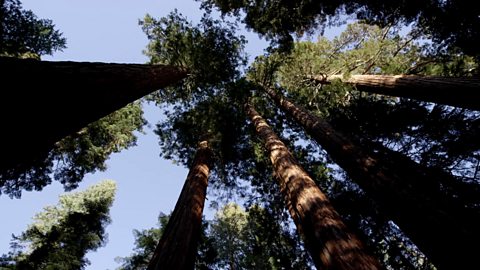
Web exclusive: Wild West mountain chill out
Drift from forested valley to mountain peak in the mountains of the Wild West.
The Wild West crew’s first tree encounter came more than 10,000 feet up on the wild, windswept peaks of the White Mountains in eastern California. This is home to a grove of bristlecone pines, gnarled and stunted trees that have been twisted into grotesque and contorted shapes by the extreme conditions. Many are over 4,000 years old and at least one is over 5,000, making it arguably the oldest living thing on the planet.
They seem to grow directly from the bleached rocks - the wood so hard and textured it's difficult to see where living tree stops and the geology begins
On arrival we found the access road to the grove still closed by winter snow. This was both a blessing and a curse; a blessing because it meant there were few other visitors to the grove, leaving us to get on with our filming uninterrupted. But a curse because with the road shut we had to hike the three miles up to the forest several times every day as we moved filming gear and heavy-duty batteries to and from the various locations, all the while gasping for breath in the thin mountain air.
The grove itself is unlike any other forest I’ve ever visited. These tenacious trees are dotted across an otherwise barren and bleak landscape. They seem to grow directly from the bleached rocks - the wood so hard and textured its difficult to see where living tree stops and the geology begins. Most look more dead than alive because after years being blasted and polished by wind-blown sand and ice, little bark or foliage remains. But they are so tough that even a thin strip of bark just a few centimetres wide is enough to keep them going.
The stark beauty of this strange, high-altitude forest was undeniable; the views across the snowy peaks of the High Sierra spectacular. But in the evening half-light, with the wind whistling, the coyotes howling and the spooky silhouettes of the bristlecones looming above us, it was all too easy to imagine a very different world: a nightmarish forest stalked by strange and blood-thirsty beasts - and not a place to linger as the light faded. The after-dark descents back down the mountain always had us looking nervously over our shoulders!
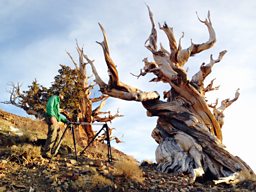
Not far away, on the gentler western slopes of the Sierra Nevada we had our next encounter with some remarkable trees - and under very different circumstances.
In Yosemite National Park stands a grove of over five hundred giant sequoias, one of the most impressive natural wonders anywhere. These are amongst the biggest trees on the planet, many close to three hundred feet tall, some with a huge girth, including the ‘Grizzly Giant’, 1,800 years old and 96 feet in circumference!
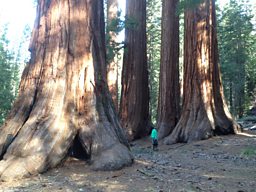
This is no remote and desolate location; the Mariposa Grove of giant Sequoias is one of Yosemite’s main attractions. The access road winds its way deep into the forest and giant trees surround the main car park. Reaching such an accessible location was a welcome relief after the exhausting slog up to the bristlecones.
The sheer scale of the trees induced a reverential hush on the masses
But every day thousands of visitors arrive to spend time among these gigantic trees - tour buses, lone hikers, honeymooners and school outings - the grove seemed to be on everyone’s "must see" list. Luckily, the forest seemed to easily soak up all these visitors, and despite the crowds, it was amazingly quiet, the sheer scale of the trees induced a reverential hush on the masses.
Our main problem filming here was how to present the scale of the trees. They are simply enormous; if you stood a jumbo jet upright on its tail, the nose would still be lost in the thick canopy! With little around to provide scale and with the lower foliage obscuring the crowns of the trees, it was a real struggle to find shots that convey just how tall these trees really are.

Later in the year, we returned to California’s Sierra Nevada, on the trail of another forest giant; the Sugar Pine. Not quite on the scale of the sequoias, these are still huge trees … and the biggest pines in the world.
On the slopes surrounding Lake Tahoe we met with members of the Sugar Pine Foundation, who work tirelessly to protect these spectacular trees. A deadly fungus accidentally imported with timber shipments from Europe is slowly killing the pines throughout the high country. But there are a few disease-resistant specimens and these are having their cones harvested by Foundation foresters, the seeds extracted and grown on in nurseries before the seedlings are replanted to help regenerate the dying forests.
Once again we were in luck with our filming location; the Foundation had found us a healthy tree loaded with fresh cones growing right in the middle of one of the most popular wild campsites on the Lake Tahoe shoreline.
Forester John Pickett was our lead character. An expert tree-climber, he has been collecting cones for the Foundation for many seasons. To film the rather perilous operation we used a specialist rope-access crew to rig both the main tree as well as its near neighbours so we could film the harvesting from every angle.
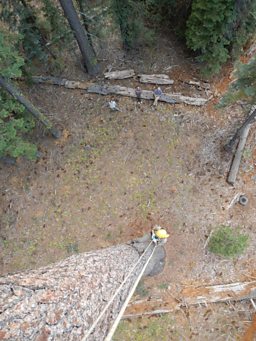
It was a baptism of fire for cameraman Dawson Dunning who had little previous experience filming in trees … and certainly not dangling from a rope over one hundred feet above the ground! Even so, he was probably a whole lot safer in his lofty perch than the rest of us waiting below as John sent down a barrage of cones.
When the massive cones, weighing as much as 4 pounds, hit the ground, they really hit the ground. There’s an old forester’s saying that advises: "never set your camp under a sugar pine". It was easy to see why as John went about his aerial acrobatics.
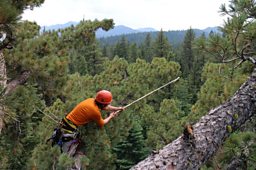
We also rigged our main Sugar Pine with a rope-and-pulley system that allowed the HD camera to be raised and lowered alongside John as he climbed. It took hours to get the system running smoothly and meant poor John had to go up and down the tree several times until we got the perfect shot.
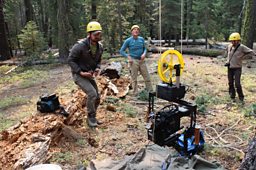
The only real moment of crisis came when the pulley system snagged half-way through the move, leaving the camera hanging vertically downwards and its on-board gyro-stabilizers going into melt down as they tried to battle gravity and re-balance the camera. With thousands of dollars of damage imminent, a well-placed knife-cut to the guide rope freed the tangle and the camera dropped gentle back to earth … just in time.
It's a dazzling but often short-lived phenomenon
Each of these Wild West forests has their own special magic and presented their own challenges to the crew, but none quite matched our autumn trip to the quaking aspen forests growing around Kebbler Pass in Colorado.
These aren’t the biggest individual trees … or the oldest trees … or even the rarest trees … but what they lack in stature and age they more than make up for in sheer scale and beauty.
Every autumn, the West Elk Mountains undergo a magical transformation as up and down the valley, the slopes are briefly blanketed in brilliant golden yellow foliage as tens of thousands of trees begin their preparations for the coming winter.
It's a dazzling but often short-lived phenomenon. Filming this spectacular change is all about timing; arrive too early and the leaves are still green, but once they begin to turn, a single storm can strip the trees of their leaves and the moment is lost for another year.
Luckily for us, interest is so great that a whole army of ‘leaf-peepers’ post daily updates online, so we had no excuse for missing the peak of the colour.
For two days all the crew could do was sit and watch as the trees were slowly stripped of their leaves
Armed with this local knowledge, our arrival was spot on, but after a great couple of days filming, the weather turned: rain, mist, and worst of all, wind. For two days all the crew could do was sit and watch as the trees were slowly stripped of their leaves.
When the weather finally eased, the local network of leaf-watchers directed the team to a protected grove tucked away in the folds of the mountains where we could finish filming before the last leaves dropped.
On our journey through the high country seasons we had stumbled upon a whole series of world record holders and been lucky enough to meet with some truly remarkable trees. To see more of these forests and many other amazing Wild West stories, tune in to ‘Wild West - The High Country.’










